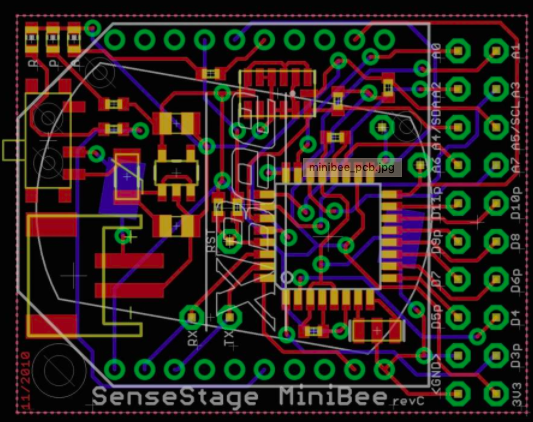Description:
The Sense/Stage MiniBee is a small, wireless sensor board, that can be configured and programmed based on the needs of its application.
-
Small size: 42mm x 35mm
-
Programmable with the Arduino software (example firmware available)
-
Low cost (first prototype series – $32 CDN + cost of XBee board ($25 – $45 CDN depending on model).
-
11 digital inputs or outputs
-
6 pulse width modulation (PWM) outputs (digital pins 3, 5,6, 9, 10 and 11)
-
8 analog inputs at 10 bits resolution
-
I2C communication (on analog pins 4 and 5)
-
Serial communication (to XBee chip or elsewhere), at maximum 19200 kbps)
-
Footprint for LIS302DL accellerometer chip
-
Power consumption: ca. 70 mA with XBee series 1 chip
The Sense/Stage MiniBee is based on the Arduino Pro Mini, and built around the ATmega168 (see the datasheet) and the XBee wireless chip.
The Sense/Stage MiniBee has 11 digital inputs or outputs (of which 6 can be used as PWM outputs) and 8 analog inputs. The board has holes for mounting pin headers to connect to these inputs and outputs. There is also a footprint for the LIS302DL accellerometer on the board. The board runs at 3.3V and 8 MHz.
The Sense/Stage MiniBee is made to fit an XBee or XBeePro chip for wireless mesh network communication in the 2.4 GHz range. It can receive and transmit serial data to this chip, and there is control over the sleep pin of the wireless chip, so energy can be saved by turning the wireless chip off.
There is example firmware for the Sense/Stage MiniBee with easy configuration to read out analog and digital data, and send out digital data or pulse width modulation. Or, use I2C to communicate to sensors, or read out ISP data. It can also receive and transmit serial data to the XBee chip at 19200 kbps.
The Sense/Stage MiniBee has been used in a network configuration with up to 35 nodes active at the same time in one room, both sending and receiving data.

